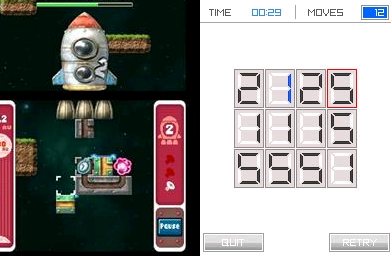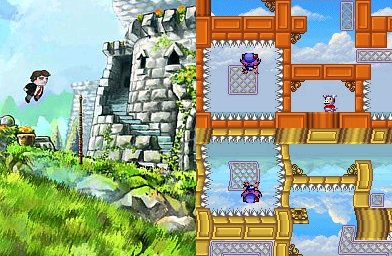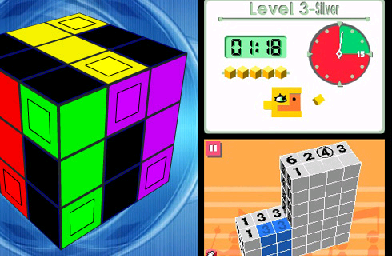Trending
Opinion: How will Project 2025 impact game developers?
The Heritage Foundation's manifesto for the possible next administration could do great harm to many, including large portions of the game development community.

Featured Blog | This community-written post highlights the best of what the game industry has to offer. Read more like it on the Game Developer Blogs or learn how to Submit Your Own Blog Post
This article takes a close look at the "undo-move" feature and how it works with 3 pairs of puzzle games. Half are complex puzzle games. Half are deep puzzle games.

[part 1] [part 2] [part 3]
There's an extension of auto-saving and loading that I haven't talked about yet. Actually, I bet most don't even consider this feature as falling under save system design. Most popular in puzzle games, a genre that I'm a huge fan of, there are "undo-move" features. Some games let players undo a single move (3D Logic), some up to 100 (Link 'n' Launch), and some allow the player to go back to any previous move (Braid, Zengage). Like any element of design, save system design features can have a big impact on how players interact with the system, learn, and progress. So, to understand the impact of undo-move save system design and to help us figure out if the feature is right for our games, we can compare my experiences with the games Base10 and Link 'n' Launch; Braid and Mighty Flip Champs!; and finally Picross 3D and 3D Logic.

Link 'n' Launch (left). Base 10 (right).
Base10 is a panel flipping game while Link 'n' Launch (LnL) is a block flipping/rotating game. In the puzzle mode of the former, players have to line up numbered panels and eliminate them by tracing vertical or horizontal lines that add up to 10. When panels are eliminated the panels will slide to the side (sideways gravity). Link 'n' Launch has more unique blocks and obstacles but no gravity. Players are challenged to rotate or flip all the connecting pipe blocks from the fuel (see pink glowing orb above) to the rocket ship at the top of the screen. Because these games stress spatial analyze knowledge skills and are so easy to manipulate, players are likely to extend their minds boosting their solving skills by manipulating the gamestate. I explain this idea thoroughly here.
In Base 10, the average number for par (the approximate minimum amount of moves needed to beat the stage) is 5 with the highest being 14. To compare, some of the hardest levels in LnL to gold must be solved in fewer than 90 moves while many of the medium difficulty puzzles average at around 15. Looking at the minimum number of moves it takes to elegantly solve these puzzles is a good indicator of how complex or difficult they are. Also, the more moves it takes to solve a puzzle, the more work the player must do to get over the complexity hump (reaching the downhill part of solving a puzzle where the solution is within sight). Because of Base 10's puzzle design, it's not so bad that Base10 doesn't have a move-undo feature. With so few necessary moves, you're never too far away from the start or the finish of the puzzle to get overwhelmed analyzing the possible combinations. Because LnL's puzzles take so many more steps to solve, the undo-move feature helps me trace my steps when I would otherwise be overwhelmed having boosted my extended mind to its limit. In other words, when I'm 45 moves into a puzzle and I can't see the shore where I started or the steps to reach the solution, it's great to be able to back up step by step to regain my bearings.

Braid (left). Mighty Flip Champs! (right)
Braid is a puzzle game that uses 2D platforming mechanics to set the stage. You control the avatar character Tim. The most unique primary mechanic in Braid is the ability to rewind time. Make just about any mistake in Braid and you can go back and try again with the push of a button. This feature is great because the rewind keeps things simple. You can only go back and then branch off from there. In other words, there is no option to save, load, or somehow store multiple files.
On the other hand, Mighty Flip Champs! (MFC) is a puzzle game that also uses 2D platformer type level design. While controlling Alta, players can easily die by touching hazards or flipping the pages of the game to wedge oneself inside a solid wall. One mistake in this game and you have to start the level over. The game challenges players to look and think moves ahead using both DS screens. With simple timing challenges, simple movement through the 2D space, and no moving enemy elements, players have sufficient information to plan their route safely.
Braid focuses more on time-space puzzles and the unique properties of the time mechanics. MFC! focuses on spatial navigation and comprehending a complex 3D space built out of cycling 2D layers. Outside of shear luck, solving Braid puzzles requires an eureka moment as you grok (comprehend) increasingly deep concepts of layered interactions. Solving MFC! puzzles is more like finding the right route in a maze. The act of navigating itself isn't very difficult, but the challenge comes from sorting through all of the complexities of possible routes without getting overwhelmed. It's a classic case of a deep puzzle game versus a complex puzzle game (read more here).
In Braid you learn new concepts and the nuances of the mechanics as you progress through the game. While learning the nuances, your trial-and-error process is aided by the REWIND TIME mechanic. MFC! wouldn't benefit as much from a undo-move feature. The maze like puzzles are challenging not because you died from an attack. They are challenging because you didn't look closely enough ahead of time or because you didn't take your time. Since the puzzles in MFC are generally closed systems, any wrong turn you make (whether you recognize it or not) leads you right back into the puzzle again so you can try again. In other words, there's not much to undo in Mighty Flip Champs.

3D Logic (left). Picross 3D (right).
It's the same situation with Picross 3D and 3D Logic. With Picross, a deductive logic puzzle game, you never have to guess to come up with the solution. If you use enough simple logic you'll always find at least one more move you can make. The tricky part of Picross 3D is keeping track of all the changes to the cube block in 3D as you rotate and alter the structure. It's easy to get overwhelmed or lose track of the overall changes. This is why Picross 3D falls more on the complex puzzle side. On the contrary, 3D Logic has much fewer spaces/blocks to consider. These levels are challenging not because of the overwhelming effect of lots of information, but the depth involved with sorting out the colored paths without crossing them. Since making every move is so simple in Picross and based on deductive logic, players are challenge to play quickly without mistakes. Make 5 mistakes and it's gameover. But working through the 3D spatial puzzles in 3D Logic is a different kind of spatial challenge that is greatly aided by hands on manipulation. Because of these fundamental differences in design, the one-move-undo feature in 3D Logic serves it well, while a similar feature would work very well in Picross 3D.
It turns out deeper puzzle systems with harder levels (more steps) benefit the most from move-undo features. This makes sense. Since depth is created from the emergent, layered interactions of game actions, comprehending the possibilties requires a branching like approach. Managing these branches typically requires frequent branching out and backing up to branch out in other direction. Move-undo helps players backup without taxing our brains. Complex puzzle challenges generally don't benefit from any kind of undo-move feature simply because of the nature of complexities. Remember complexities cannot be compressed. Because you have to analyze all the parts of a complex puzzle individually, there's little to gain, fail, and therefore undo by investigating any part. It's like having an undo button for a jigsaw puzzle. What function would it serve? If two pieces don't exactly fit, just pull them apart. You still have hundreds of other pieces to consider to find the match.
Other games that have move-undo features are Prince of Persia, Full Auto, Grid, Dirt 2, Forza Motorsport 3, and Ogre Battle: Let Us Cling Together.
That's it for our look into save system design. Don't worry. Though this is the end, I'm not going to save over your progress. Feel free to go back and complete all the side quests this blog has to offer.
Read more about:
Featured BlogsYou May Also Like